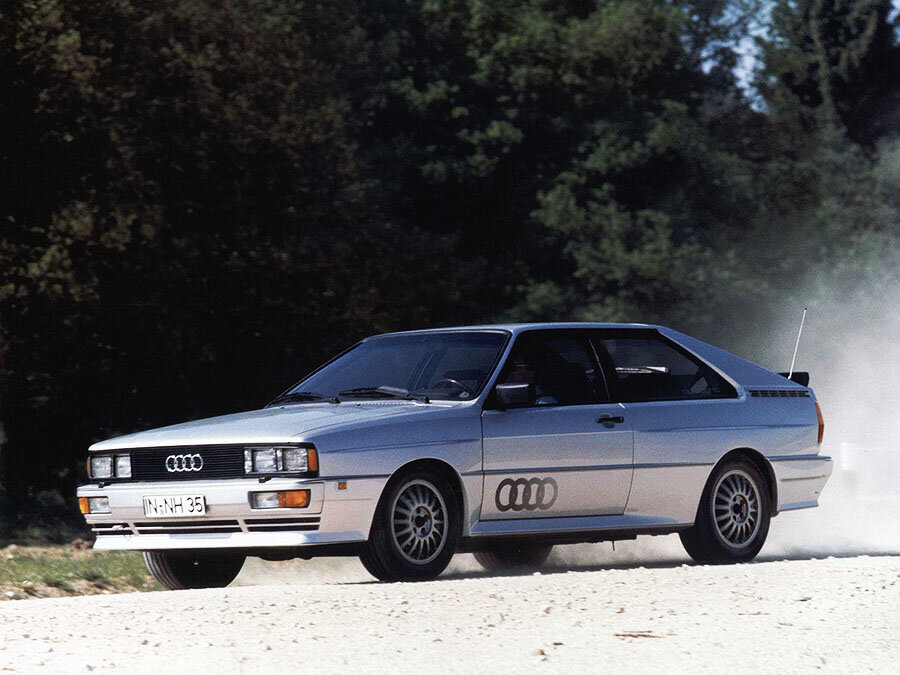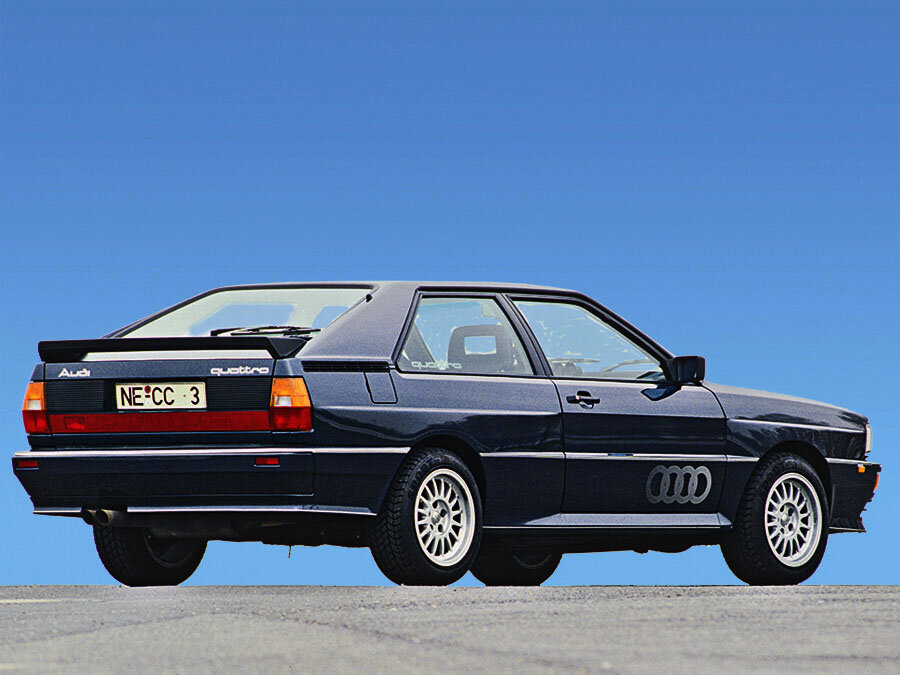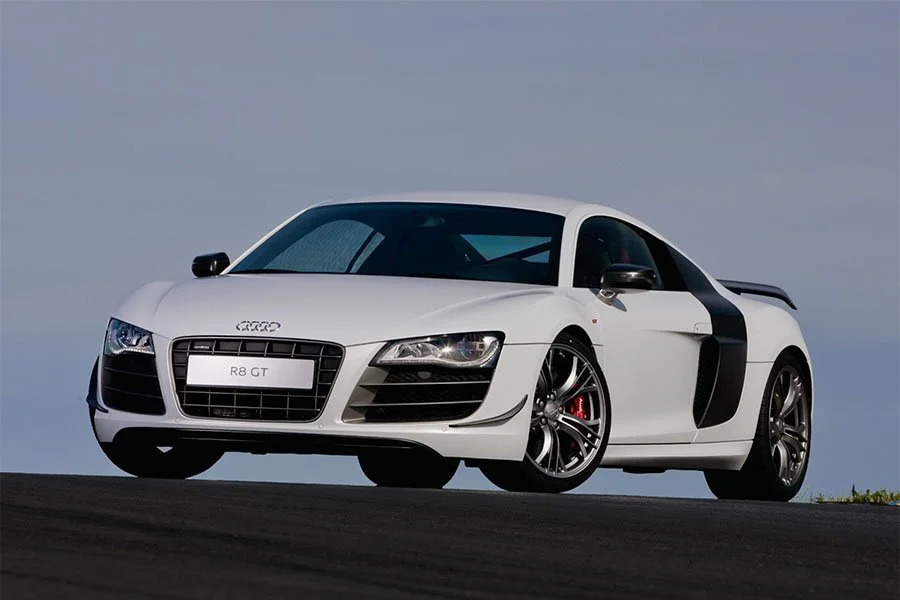Guide: Audi Quattro UR - a Historical & Technical Appraisal
/BACKGROUND
Volkswagen re-launched the Audi brand in 1965 soon after they had acquired a 50% holding in the business.
18 months later, VW took complete control and, over the next 15 years, Audi established a reputation for reliable and well-engineered albeit conservative machinery.
During the 1980s, Audi’s image was transformed by a new model known as the Quattro.
Unveiled at the Geneva Motor Show in March 1980, the Quattro was produced until 1991, by which time nearly 11,500 had been sold.
The Quattro was the first four-wheel drive sports car, a concept originally proposed by Audi’s chassis engineer, Jorg Bensinger.
While in Finland testing Volkswagen’s small all-terrain military vehicle, the Iltis, Bensinger noticed how it could outperform any other vehicle in the snow, no matter how powerful.
On his return to Ingolstadt, Bensinger proposed the idea of a sporting four-wheel drive model to Walter Treser, Audi’s Director of Pre-Development.
A four-wheel drive Audi 80 test car code named the A1 (Allrad 1) was created and, in September 1977, the hitherto un-budgeted A1 received the go-ahead from Audi’s board.
In addition to its handsome looks and fantastic all-round performance, part of the Quattro’s appeal lay in its competition prowess. In 1979, the FIA had legalised four-wheel drive for use in rallying and Audi management saw the sport as a perfect platform to demonstrate their new car’s superior technology.
Prior to the Quattro’s arrival, most manufacturers considered four-wheel drive too complex to be successful. That soon changed.
Each Quattro was hand-built at a special hall in Audi’s Ingolstadt factory staffed by a team of 48 personnel.
Once completed, every Quattro went through a quality control programme that was far stricter than for any other Audi. Such attention to detail was reflected in the price: upon launch, the Quattro cost DM49,000 which was almost two-and-a-half times as much as the two-wheel drive, narrow-bodied and normally-aspirated Audi Coupe GT.
CHASSIS
The Quattro and Coupe GT shared many core components, most notably the B2 pressed steel unibody platform with its 2524mm wheelbase.
Fully independent suspension was via a MacPherson strut, lower wishbone and a coil sprung gas-filled telescopic damper at each corner. If turned through 180°, the Quattro’s suspension arrangement was virtually interchangeable front to rear.
Hydraulically assisted disc brakes were ventilated at the front (280mm diameter) and solid at the rear (245mm diameter).
Power steering was fitted as standard and a 90-litre fuel tank was installed above the rear axle.
Ronal supplied the 15 x 6-inch light alloy wheels which originally came shod with Goodyear tyres.
ENGINE / TRANSMISSION
For the Quattro’s powerplant, Audi started with the 2.2-litre inline five-cylinder turbocharged engine fitted to the 200 5T.
Introduced at the Frankfurt Motor Show in September 1979, the 200 5T was Audi’s flagship saloon.
The engine featured a cast iron block and aluminium alloy single overhead camshaft head with two valves per cylinder. Displacement was 2144cc thanks to a bore and stroke of 79.5mm and 86.4mm respectively.
A Borg Warner KKK K26 turbo ran at 0.68 bar and engine compression was 7.0:1.
Fuel-injection was the eponymous Bosch K-Jetronic.
All told, the 200 5T engine produced 170bhp at 5300rpm and 198lb-ft at 3300rpm.
By adding an air-to-air intercooler, fully electronic ignition and a big bore exhaust, Audi coaxed an extra 30bhp for the Quattro’s ‘WR’ engine. This meant 200bhp was now available at 5500rpm and there was also a useful increase in torque with 210lb-ft now on tap at 3500rpm.
The Quattro was the first high performance production vehicle to use electronic engine management. Supplied by Hitachi, the Engine Control Unit (ECU) recorded boost levels, inlet air temperature and crank position. A set of internal maps then generated the timing information.
All Quattros came with a five speed manual gearbox and hydraulically operated single dry plate clutch. The permanent four-wheel drive system was light in weight and featured a central differential to eradicate low-speed jumpiness. A hollow gearbox output shaft turned a diff mounted behind the gearbox, another shaft inside the hollow shaft then sent drive back to the front axle. A further propshaft sent drive from the central diff to the rear axle.
To enable full exploitation of the four-wheel drive system, diff locks activated by switches either side of the handbrake were added to the rear and centre differentials.
Torque was split 50/50 front to rear.
BODYWORK
Body styling was undertaken by Audi designer, Martin Smith.
Compared to the Coupe GT, Quattros received a host of special upgrades.
All four wheelarches were flared to accommodate the wider wheels and tyres.
Body-coloured impact-absorbing fibreglass bumpers were fitted, each with a bespoilered apron.
Body-coloured side skirts were another unique Quattro detail along with a rear spoiler and Audi graphics on the doors.
INTERIOR
Inside, the seats, door panels and headliner were upholstered in typically 1980s duo-pattern velour.
The instrument binnacle housed two main dials (a speedo and tach) plus smaller gauges for turbo boost and fuel plus a clock. Warning lights were located in the centre of the binnacle and various control switches were mounted down each flank.
The central console was home to the ventilation controls, a stereo and a display indicator for the differential locks.
The four-spoke steering wheel was fully adjustable and had a leather rim as standard. Also upholstered in leather was the gear knob and gaiter.
Electric windows, central locking, a Blaupunkt stereo, headlight washers, front and rear fog lights and a tinted windscreen were all standard equipment.
OPTIONS
Optional upgrades included 7 x 15-inch wheels, leather upholstery, air-conditioning, a sunroof and a three-channel Anti-lock Brake System (ABS). The ABS controlled the front wheels separately and the rear wheels in unit. It could be switched off for snowy conditions and was automatically disabled if the differential locks were engaged.
WEIGHT / PERFORMANCE
Overall weight for the Quattro was 1300kg.
Top speed was 137mph and 0-62mph took 7.1 seconds. However, it was traction and roadholding where the car really excelled.
PRODUCTION BEGINS
Following its launch at the Geneva Motor Show in March, the first customer cars were delivered in November 1980. These early Quattros were 1981 model year derivatives.
UK deliveries started in March 1981 but, at this stage, the Quattro was only available in left-hand drive.
Audi had announced they had no plans to make a right-hand drive version so a number of firms began to convert them. The best were done by David Sutton Motorsport who were the official representative of Audi Sport UK.
1982 MODEL YEAR
For the 1982 model year (production of which started in August 1981), the cam and combustion chambers were modified.
1983 MODEL YEAR
More significant changes arrived for the 1983 model year (manufactured from August 1982).
New one-piece Cibie headlights were fitted and drop-links were added to the front anti-roll bar mountings to reduce noise transmitted through the body.
The rear anti-roll bar was removed altogether and the rear suspension geometry was reworked. This reduced the car’s tendency for lift-off oversteer, improved its straight line stability and lessened sensitivity to crosswinds.
NORTH AMERICAN VERSION
For the first time, Quattro sales began in North America but, as a large batch of cars had been prepared in advance of type approval, they did not initially include the 1983 model year changes.
Quattros destined for the USA and Canada came with larger impact bumpers plus leather upholstery and air-conditioning as standard.
They also came with a ‘WX’ engine that featured ECU changes, lowered turbo boost, a different camshaft, a catalytic converter and Lambda stoichiometric fuel control. Power output dropped to 160bhp.
The ‘WX’ engine was also used in Swiss and Japanese market Quattros.
Production of US-spec. variants continued until 1986.
RIGHT-HAND DRIVE PRODUCTION BEGINS
In October 1982, Audi reversed their earlier decision and began to offer a right-hand drive Quattro. It proved a good decision as the UK became the firm’s best export market for the model.
MID 1983 MODEL YEAR CHANGES
In April 1983, the dashboard was switched from analogue instrumentation to digital green readouts. The update also included the arrival of a female voice synthesiser that automatically gave commands such as ‘Please Refuel’.
1984 MODEL YEAR
The 1984 model year Quattros (built from August 1983) saw the most substantive changes yet.
Both the instrument binnacle and centre console were redesigned along with all the switchgear. To replace the ageing original, Audi fitted the leather steering wheel from their 200 model.
ABS became standard and the wheels were widened from 6 to 8-inches. Now shod with Pirelli Cinturato P5 tyres, slight modifications were made to the wings to accommodate the new wheel and tyre combination.
At the same time, the suspension was modified with new springs and slightly stiffer shock absorbers. The ride height was lowered by 20mm, all of which further enhanced handling.
1985 MODEL YEAR
For the 1985 model year (produced from August 1984), the Quattro received its only significant external facelift.
The headlights and front grille were subtly raked backwards to improve the car’s aerodynamic value. This had the effect of slightly increasing top speed and also helped the headlights to stay clean.
At the rear, the tail lights and reflective central panel were given a smoked effect while the spoiler became body coloured. Badges replaced decals on the tailgate.
More changes were made inside where much higher quality materials were used.
The lower dash, centre console, arm rests and door pockets were now upholstered in leather. The central console itself had been redesigned and extended all the way back to the rear seats. The upper dash was switched to an elegant hard foam material.
New seats came with leather bolsters and the fabric centres had ‘quattro’ script to match the door panels.
The seat heater was replaced with separate thermostatic controls for the driver and passenger.
1986 MODEL YEAR
1986 model year Quattros (manufactured from August 1985) saw the differential lock changed from a pull type to a rotary switch. Thanks to a smaller diff lock graphic on the centre console, there was now space for digital battery voltage and oil temperature read outs.
Gas-filled struts were fitted to the bonnet.
1987 MODEL YEAR
The 1987 model year was the last UR Quattro before the bigger-engined MB variant arrived.
A longitudinal accelerometer (a mercury motion detector) was added to the ABS system which provided a fifth input about vehicle dynamics.
Additionally, a Torsen centre differential replaced the manual centre differential lock.
Text copyright: Supercar Nostalgia
Photo copyright: Audi - https://www.Audi.com



































